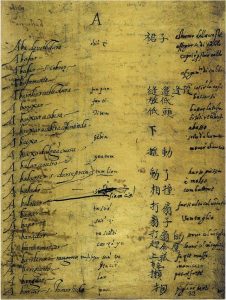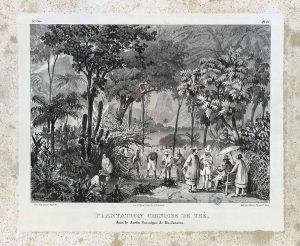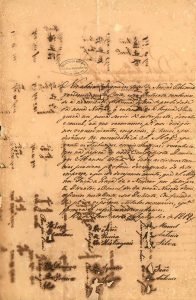Brazil meets the Far East: the Chinese Mission
< Back to Dossiês- Portugues Brasil
- |
- 中文
- |
- English
Brazil meets the Far East: the Chinese Mission
When the diplomat Henrique Lisboa disembark in China in 1880, his mission was clear: know the Chinese civilization. Two years earlier, at the 'Agricultural Congresses' in the city of Recife and in the city of Rio de Janeiro in 1878, the discussion on the massive importation of Chinese was the main theme. An country dependent on agricultural production and slaves, Brazil discussed in Congress and in the streets of the cities whether free Chinese workers should be contract and brought in to replace the African and afro brazilian slaves.
Brazilians had little knowledge about China. At the time of King of Portugal Dom João VI (1815-1826), a group of Chinese came to Brazil to plant tea, forming the first Chinese community in America. The venture was unsuccessful; but the Chinese have integrated into Brazilian society.

Fig. 1 - Between the 16th and 18th centuries, whoever wanted to learn the Chinese language would probably have to go through Macau and, there, could find materials like this - the first Chinese dictionary for a western language was made in Portuguese, by priests Matteo Ricci ( 1552-1610) and Michelle Ruggieri (1543-1607), and published in the Portuguese colony.
Source: Portuguese-Chinese Dictionary, org. by John Witek. Lisbon: Portuguese Institute of the East, 2001.

Fig. 02 - Throughout the 19th century, Portuguese and Brazilians could use Joaquim Afonso Gonçalves' 1831 dictionary to learn Chinese, showing that the study of China was something that interested us. Image captured from the front page of the dictionary, in Internet Archive.
Source: Collection of the National Library Foundation.

Fig. 03 - Title page of the book Memory on the Macao Government Expedition..., by Lucas José Alvarenga (Governor of Macao). At the time when Brazil was still a colony of Portugal, several Brazilians acted in a relevant way in the East, helping to promote important cultural transits.
Source: Collection of the National Library Foundation.

Fig. 04 - Watercolor by Johann Moritz Rugendas of the Chinese planting tea in Rio de Janeiro: Brazil was the first country in the West to receive an official Chinese colony.
Source: Collection of the National Library Foundation.

Fig. 05 - A very rare document: the request, made by Chinese settlers who planted tea, for an interpreter. It was signed by them with their Chinese and Brazilian names. The only copy is available in the BN collection, which we can consult on the net.
Source: Collection of the National Library Foundation.
However, in 1878, much time had passed. Average Brazilians did not have much knowledge about China and the Far East. For this reason, the Brazilian Empire decided send a mission to China. The aim was to establish official diplomatic and trade relations with the Qing Dynasty (1644-1911). The voyage was described in Brazilian government reports and in the first work of sinology written in Brazil. The book ‘The China and the Chinese’ [‘A China e os chins’, 1888] was written by the diplomat Henrique Lisboa, and constitutes an important source of cultural and historical information about China. Henrique Lisboa achieved to capture Chinese society in depth. His immersion in Chinese everyday life led him to observe their customs and ideas, which would allow him to build a more conscious and realistic image of the Chinese for the Brazilian public.
This is what we are going to present, now in the dossier ‘Brazil meets the Far East: the Chinese Mission’, produced with the collection of the Fundação Biblioteca Nacional brasileira [Brazilian National Library Foundation].
Brazilians had little knowledge about China. At the time of King of Portugal Dom João VI (1815-1826), a group of Chinese came to Brazil to plant tea, forming the first Chinese community in America. The venture was unsuccessful; but the Chinese have integrated into Brazilian society.

Fig. 1 - Between the 16th and 18th centuries, whoever wanted to learn the Chinese language would probably have to go through Macau and, there, could find materials like this - the first Chinese dictionary for a western language was made in Portuguese, by priests Matteo Ricci ( 1552-1610) and Michelle Ruggieri (1543-1607), and published in the Portuguese colony.
Source: Portuguese-Chinese Dictionary, org. by John Witek. Lisbon: Portuguese Institute of the East, 2001.

Fig. 02 - Throughout the 19th century, Portuguese and Brazilians could use Joaquim Afonso Gonçalves' 1831 dictionary to learn Chinese, showing that the study of China was something that interested us. Image captured from the front page of the dictionary, in Internet Archive.
Source: Collection of the National Library Foundation.

Fig. 03 - Title page of the book Memory on the Macao Government Expedition..., by Lucas José Alvarenga (Governor of Macao). At the time when Brazil was still a colony of Portugal, several Brazilians acted in a relevant way in the East, helping to promote important cultural transits.
Source: Collection of the National Library Foundation.

Fig. 04 - Watercolor by Johann Moritz Rugendas of the Chinese planting tea in Rio de Janeiro: Brazil was the first country in the West to receive an official Chinese colony.
Source: Collection of the National Library Foundation.

Fig. 05 - A very rare document: the request, made by Chinese settlers who planted tea, for an interpreter. It was signed by them with their Chinese and Brazilian names. The only copy is available in the BN collection, which we can consult on the net.
Source: Collection of the National Library Foundation.
»See more: Carlos Francisco Moura talks about “Relations between Brazil and Macau in the 19th century”, and Ouvidor Brum da Silveira's plan to send Chinese to Brazil.
However, in 1878, much time had passed. Average Brazilians did not have much knowledge about China and the Far East. For this reason, the Brazilian Empire decided send a mission to China. The aim was to establish official diplomatic and trade relations with the Qing Dynasty (1644-1911). The voyage was described in Brazilian government reports and in the first work of sinology written in Brazil. The book ‘The China and the Chinese’ [‘A China e os chins’, 1888] was written by the diplomat Henrique Lisboa, and constitutes an important source of cultural and historical information about China. Henrique Lisboa achieved to capture Chinese society in depth. His immersion in Chinese everyday life led him to observe their customs and ideas, which would allow him to build a more conscious and realistic image of the Chinese for the Brazilian public.
This is what we are going to present, now in the dossier ‘Brazil meets the Far East: the Chinese Mission’, produced with the collection of the Fundação Biblioteca Nacional brasileira [Brazilian National Library Foundation].